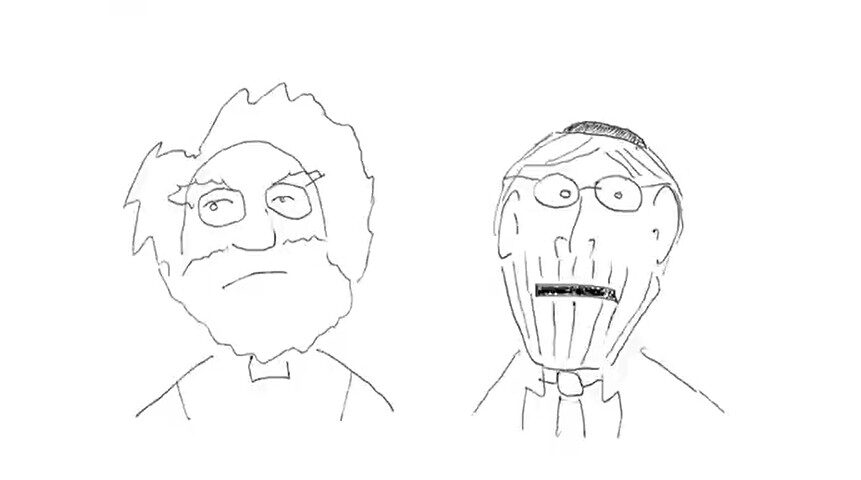The BEST: The Rabbinic Image Reimagined

“The BEST” series is a bi-weekly feature in which writers consider what things “out there” make us think and feel. What elements in our culture still inspire us to live better? We seek to share what we find that might still be described as “the best that has been thought and said.” Click here to read about “The BEST” and to see the index of all columns in this series.
Summary
Short social media videos have become a defining cultural force, reshaping how people communicate, learn, and express identity. TikTok videos, Instagram Reels, and YouTube Shorts democratize storytelling, allowing anyone with a smartphone to reach global audiences. These micro-videos compress humor, commentary, and education into bite-sized, algorithm-friendly forms which cater to shrinking attention spans that demand immediacy. They blur the boundaries between entertainment, news, and activism, transforming users into both consumers and creators of culture. In doing so, they have not only redefined trends and aesthetics but also altered how ideas, values, and social movements spread—favoring the visual, the emotional, and the viral over the reflective and sustained. While it’s often difficult to call such content “the best that has been thought and said,” this medium is the message, and that’s why it matters.
Jay Foreman and Mark Cooper-Jones are British comedians and educators known for transforming obscure topics into witty, informative entertainment. With their Unfinished London, Map Men, and Politics Unboringed series, they have built a distinctive niche at the crossroads of comedy, education, and curiosity. In 2012, they released a short video which casts two eminent religious leaders—Jonathan Sacks (then Chief Rabbi) and Rowan Williams (then Archbishop of Canterbury)—as hapless private detectives running “unsuccessful detective agencies” as side hustles. The conceit plays on the detective-agency trope that English literature and culture have long embraced: the dignified figure of the sleuth who observes, deciphers clues, and restores order. But here the twist is that our sleuths are ecclesiastical. The sly irreverence of British humor is fully on display, respectful of the figures’ gravitas and gently subverting it by placing them in an incongruous genre of comic detection. In doing so, Foreman and Cooper-Jones use the familiar detective motif not only for laughs, but to nod subtly to the idea that spiritual leaders may likewise be expected to “investigate” moral questions or social puzzles, just here they’re humorously failing at it.
Why this is “The BEST”
The image of the rabbi in modern Jewish life and literature has undergone a profound transformation over the past half century. Once seen primarily as a parochial leader, a figure of nostalgic piety or communal authority, the rabbi has gradually become a symbol of moral imagination and philosophical depth. This shift is nowhere clearer than in the contrast between mid-twentieth-century portrayals of rabbis in Anglophone fiction and their contemporary reimagining. Where earlier writers like Saul Bellow, Philip Roth, and Bernard Malamud often treated rabbis as comic foils or anachronistic relics of immigrant life, more recent voices have recast them as intellectual interlocutors in the great moral debates of the modern world.
A key turning point in this evolution was the public career of Rabbi Jonathan Sacks. As Chief Rabbi of the United Kingdom, and later as a global religious thinker, Sacks modeled a form of rabbinic leadership that spoke beyond the synagogue and beyond the Jewish community. His writings wove together Torah scholarship, philosophy, and contemporary ethics, articulating a Judaism that could converse fluently with secular culture. In the decades following his emergence, novelists such as Allegra Goodman, Nicole Krauss, Dara Horn, and—yes—comedians like Jay and Mark began to present learned Jewish figures that embodied this intellectual and spiritual confidence. Their rabbis and scholars no longer linger at the margins of Jewish identity but engage directly with questions of mortality, transcendence, and moral responsibility. (An earlier exception to the mid-century antiquated rabbinic persona was Harry Kemelman’s Rabbi Small Mystery Series, with twelve volumes published between 1964 and 1996. Although using Talmudic thinking to solve many a fictional crime, David Small never actually opened a detective agency.)
This “post-Sacks” archetype of the rabbi—a calm, humane, and intellectually fluent moral teacher—reflects a broader cultural shift: the normalization of the rabbi as a credible global moral philosopher. Yet this literary development also parallels a sociological transformation. The center of gravity in Jewish life has moved away from traditional synagogues and denominational structures toward a more decentralized, entrepreneurial religious landscape. In many corners of the Jewish world, the rabbi’s task has shifted from adjudicating Jewish law to translating Jewish wisdom—helping individuals find resonance in traditions that are no longer self-evident. In this sense, the rabbi is no longer merely a teacher of texts but a cultural translator, mediating between an ancient inheritance and a secular, pluralistic present; a detective, if you will. His image—animated, cartoonish, or otherwise—has begun to reflect this.
Chaim Strauchler, an associate editor of TRADITION, is rabbi of Cong. Rinat Yisrael in Teaneck.
